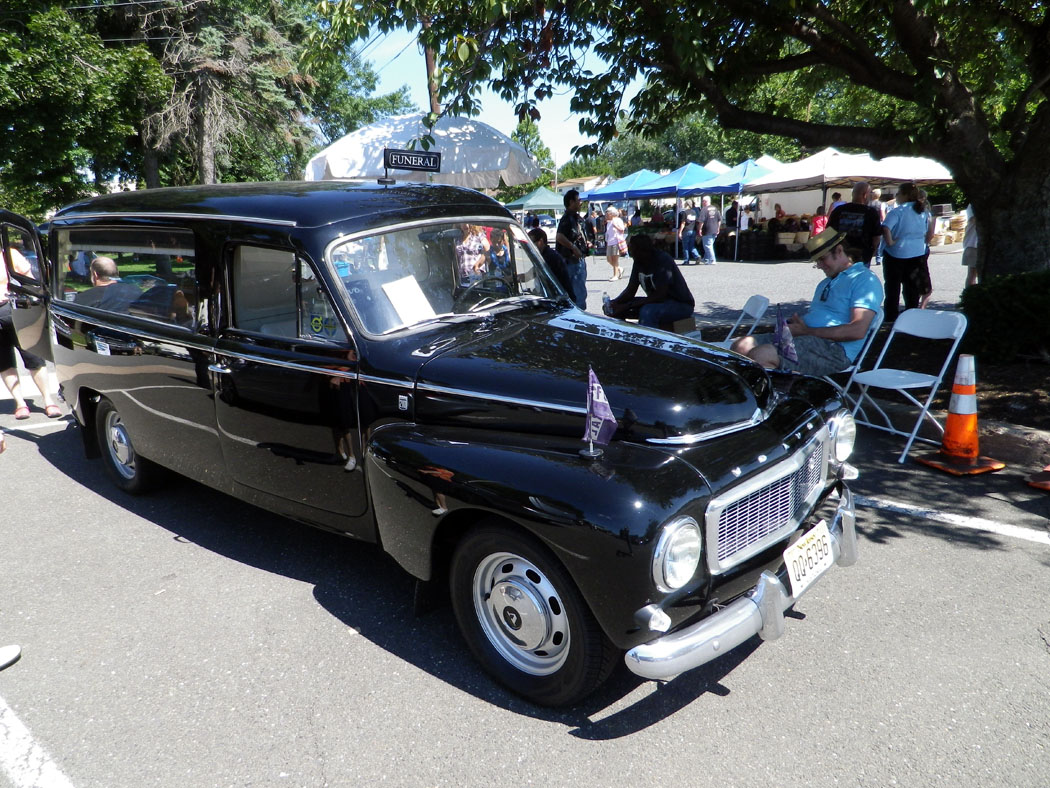Don’t Fear the (Grim) Reaper
A 1965 Volvo hearse enjoys a new life spreading good cheer
Imagine a heavy Volvo wagon with no air conditioning, unassisted brakes and steering, and a four-speed stick shift. The two front seats don’t recline and there isn’t even a radio. The car’s stiff suspension sends tremors through the cabin, which lacks sound insulation. The highway driving noise could almost, well, wake the dead.
At least the rear passenger was assured of a peaceful ride … to the cemetery.
Chances are good you’ve never seen a Volvo hearse. This is one of just three like it in the world, according to Greg Miller and his partner, Will Van Allen, who’ve owned this curious 1965 Volvo for the past 20 years. It’s also the only one in North America.
Despite the lack of creature comforts, they jump at the chance to drive the car several hundred miles to major Volvo shows and gatherings. That’s more traveling than it did in its previous life shuttling passengers to their final resting places.
Understandably, the car draws attention wherever they take it. The coffin that rides in the back garners extra attention. It’s no prop; it’s the genuine article, originally belonging a family trying to send its deceased patriarch back to Portugal. Here, it serves double duty, adding just the right amount of macabre spirit and serving as a storage bin for those long drives. The car is a hit at Professional Car Society shows, where Miller and Van Allen are asked to draw the car’s curtains so the coffin is not visible.
Why a Volvo hearse? Why not, Miller and Van Allen, who live in Trenton, N.J., would say. They bought it on a whim. Joe Lazenby, whose Susquehanna Spares specializes in parts for older Volvos, told them about it and showed them photos of the car in Sweden, where it had been used by a funeral home for 30 years.
The hearse was converted from a Volvo wagon known as the Duett, which was built from 1953 to 1969 in two series. The first was called the PV445, built until 1960, and the second was the P210, built until 1969. The P210 series used front bodywork from the 544-series passenger car.
Unlike Volvo cars, which were unit-body, the Duett used body-on-frame construction. That enabled Volvo to build various configurations, and it allowed coachbuilders to build professional cars, including this hearse made by Heinel Verkstads.
The hearse had traveled only about 18,000 miles in its professional career, but you can imagine the rain, snow and mud it had seen over all those trips to cemeteries. So, rust in the floors, rocker panels and doors was not a surprise. That didn’t stop Miller from using the car to take his mother shopping on Saturdays.
“She thought I was nuts when I bought it,” he said. “But she came to love it.”
The car would draw a small crowd on every shopping expedition. An aunt in Yardley, Penn., enjoyed riding in it, as well. “She and her husband had a curved-dash Oldsmobile that they drove around, so she really appreciated this car,” Miller said.
Volvo, for its part, has long appreciated the appeal of this hearse, inviting the owners to show it at company events. But the car was in need of restoration. After the president of Volvo Cars North America at the time saw the car 13 years ago, the company’s PR manager, Dan Johnston, connected Miller and Van Allen with FAPS, the vehicle preparation company Volvo uses in port Elizabeth, N.J.
In just three months, the FAPS craftsmen completely rehabilitated the body, including fabricating specials parts that were not available. The paintwork, you might say, is drop-dead gorgeous.
The car’s original B18 1.8-liter four-cylinder engine, with just 75 horsepower, works hard to move the big hearse, but then, the car’s usual passengers were not in a hurry.
The six-gallon fuel tank wasn’t an issue in the car’s original line of work, but highway trips require a stop about every two hours, Miller explained. Van Allen does the driving, as Miller is in a wheelchair. The frequent fuel stops seem to time well with the need to get out of the car for a rest – a temporary rest, that is.
The duo embrace the ghoulish fun the car generates. They nicknamed their special Volvo “Val” for Valhalla, in Norse mythology the banquet hall of the god Odin, where soldiers killed in battle went to their reward. The ceramic skull is “Yorick.”
As for the “Volvo for life” license plate, perhaps that should read “Volvo, for the afterlife.”


